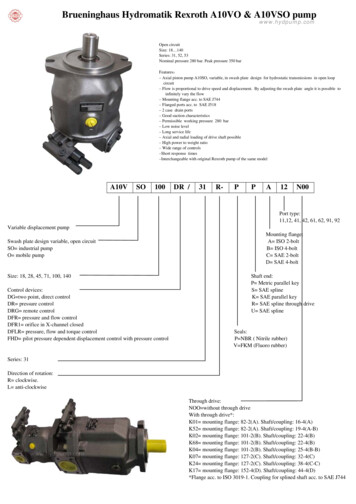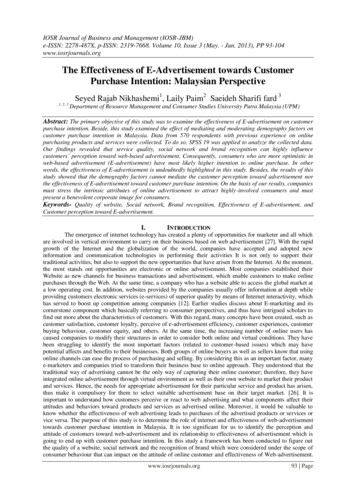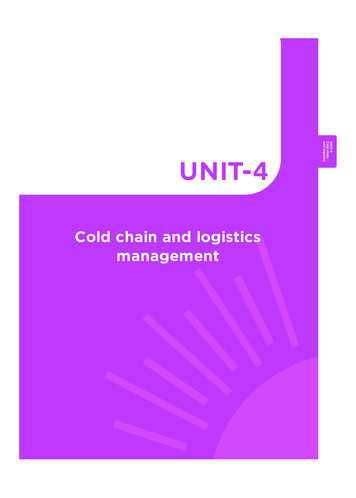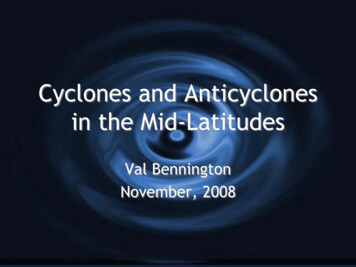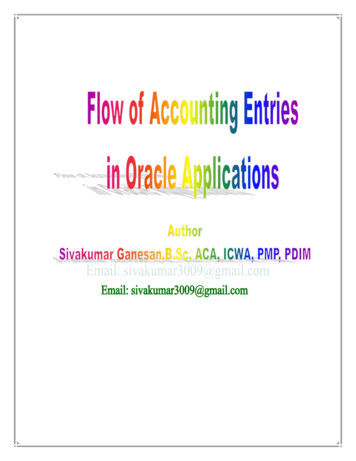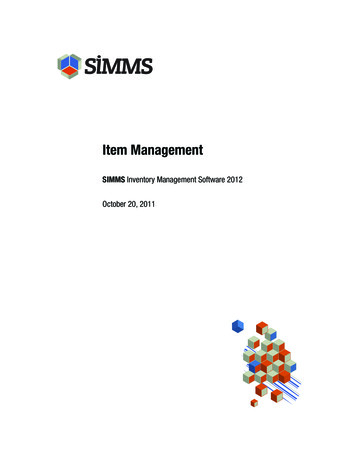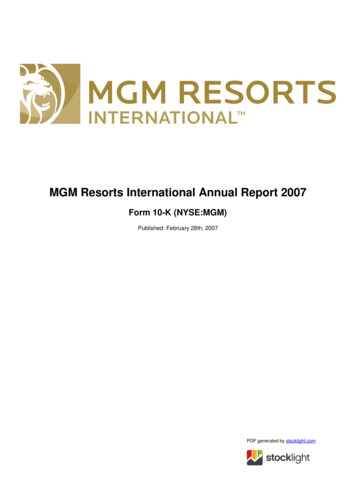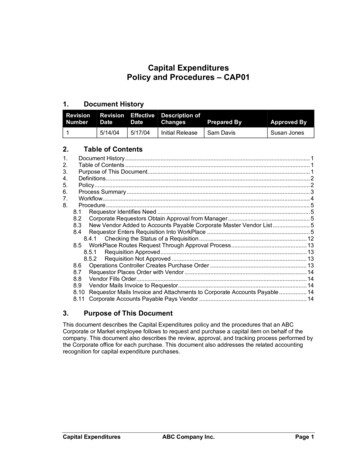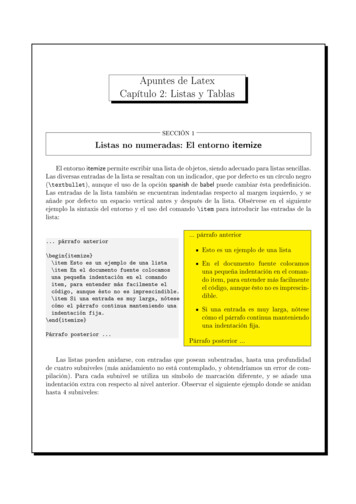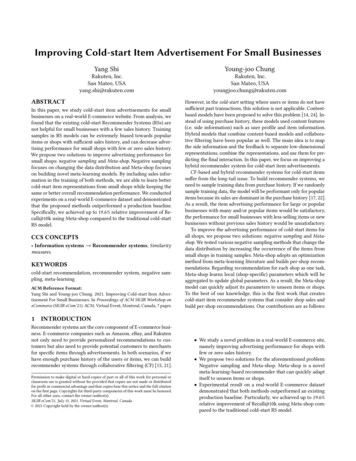
Transcription
Improving Cold-start Item Advertisement For Small BusinessesYang ShiYoung-joo ChungRakuten, Inc.San Mateo, USAyang.shi@rakuten.comRakuten, Inc.San Mateo, USAyoungjoo.chung@rakuten.comABSTRACTIn this paper, we study cold-start item advertisements for smallbusinesses on a real-world E-commerce website. From analysis, wefound that the existing cold-start Recommender Systems (RSs) arenot helpful for small businesses with a few sales history. Trainingsamples in RS models can be extremely biased towards popularitems or shops with sufficient sales history, and can decrease advertising performance for small shops with few or zero sales history.We propose two solutions to improve advertising performance forsmall shops: negative sampling and Meta-shop. Negative samplingfocuses on changing the data distribution and Meta-shop focuseson building novel meta-learning models. By including sales information in the training of both methods, we are able to learn bettercold-start item representations from small shops while keeping thesame or better overall recommendation performance. We conductedexperiments on a real-world E-commerce dataset and demonstratedthat the proposed methods outperformed a production baseline.Specifically, we achieved up to 19.6% relative improvement of Recall@10k using Meta-shop compared to the traditional cold-startRS model.CCS CONCEPTS Information systems Recommender systems; Similaritymeasures.KEYWORDScold-start recommendation, recommender system, negative sampling, meta-learningACM Reference Format:Yang Shi and Young-joo Chung. 2021. Improving Cold-start Item Advertisement For Small Businesses. In Proceedings of ACM SIGIR Workshop oneCommerce (SIGIR eCom’21). ACM, Virtual Event, Montreal, Canada, 7 pages.1However, in the cold-start setting where users or items do not havesufficient past transactions, this solution is not applicable. Contentbased models have been proposed to solve this problem [14, 24]. Instead of using purchase history, these models used content features(i.e. side information) such as user profile and item information.Hybrid models that combine content-based models and collaborative filtering have been popular as well. The main idea is to mapthe side information and the feedback to separate low-dimensionalrepresentations, combine the representations, and use them for predicting the final interaction. In this paper, we focus on improving ahybrid recommender system for cold-start item advertisements.CF-based and hybrid recommender systems for cold-start itemssuffer from the long-tail issue. To build recommender systems, weneed to sample training data from purchase history. If we randomlysample training data, the model will be performant only for popularitems because its sales are dominant in the purchase history [17, 22].As a result, the item advertising performance for large or popularbusinesses with many and/or popular items would be satisfactory,the performance for small businesses with less-selling items or newbusinesses without previous sales history would be unsatisfactory.To improve the advertising performance of cold-start items forall shops, we propose two solutions: negative sampling and Metashop. We tested various negative sampling methods that change thedata distribution by increasing the occurrence of the items fromsmall shops in training samples. Meta-shop adopts an optimizationmethod from meta-learning literature and builds per-shop recommendations. Regarding recommendation for each shop as one task,Meta-shop learns local (shop-specific) parameters which will beaggregated to update global parameters. As a result, the Meta-shopmodel can quickly adjust its parameters to unseen items or shops.To the best of our knowledge, this is the first work that createscold-start item recommender systems that consider shop sales andbuild per-shop recommendations. Our contributions are as follows:INTRODUCTIONRecommender systems are the core component of E-commerce business. E-commerce companies such as Amazon, eBay, and Rakutennot only need to provide personalized recommendations to customers but also need to provide potential customers to merchantsfor specific items through advertisements. In both scenarios, if wehave enough purchase history of the users or items, we can buildrecommender systems through collaborative filtering (CF) [15, 21].Permission to make digital or hard copies of part or all of this work for personal orclassroom use is granted without fee provided that copies are not made or distributedfor profit or commercial advantage and that copies bear this notice and the full citationon the first page. Copyrights for third-party components of this work must be honored.For all other uses, contact the owner/author(s).SIGIR eCom’21, July 15, 2021, Virtual Event, Montreal, Canada 2021 Copyright held by the owner/author(s). We study a novel problem in a real-world E-commerce site,namely improving advertising performance for shops withfew or zero sales history. We propose two solutions for the aforementioned problem:Negative sampling and Meta-shop. Meta-shop is a novelmeta-learning-based recommender that can quickly adaptitself to unseen items or shops. Experimental result on a real-world E-commerce datasetdemonstrated that both methods outperformed an existingproduction baseline. Particularly, we achieved up to 19.6%relative improvement of Recall@10k using Meta-shop compared to the traditional cold-start RS model.
SIGIR eCom’21, July 15, 2021, Virtual Event, Montreal, Canada2 RELATED WORK2.1 Hybrid recommender systems forcold-start problemsVarious hybrid methods have been proposed to tackle the cold startproblem. Collaborative topic regression (CTR) [33] and its variants [13, 34] have been one of popular model structures. Based onthe availability of feedback information, CTR interpolates betweencontent-based representations generated from side information byLatent Dirichlet Allocation (LDA) [4] and feedback-based ones generated from interaction matrices by weighted matrix factorization(WMF).Recent hybrid methods utilize neural networks to learn representations from side information. To solve the cold-start problem in themusic recommendation system, DeepMusic [28] created multipleembeddings based on contents (e.g. artist biographies and audiospectrogram) using neural networks like convolutional neural networks. Several researchers [6, 9, 19, 20, 38] utilized various autoencoders to learn representation of side information. For example,Dong et al. [9] combined additional stacked denoising autoencoder[31] and matrix factorization to integrate side information.Attention mechanisms were also introduced to improve the recommendation performance. Attentional collaborate&content models (ACCM) [27] used attention mechanisms to adjust the importance of source information. For cold start items whose feedbackinformation is missing, ACCM pays more attention to the item’sside information to make predictions.Some works focused on integrating side information and the preference representations generated by feedback information. Bianchiet al. utilize feedbacks from multi-brand retailers and align itemembeddings across shops using translation models. Dropoutnet [32]takes preference representation and side information as inputs foritems. For a cold start item, the values of preference representationsare set to be zero because past interaction is missing; CB2CF [3]learns a mapping function from side information to preferencerepresentation. Both Dropoutnet and CB2CF need to first learnpreference representations by applying a matrix factorization algorithm to the interaction matrix.2.2Recommender systems forlong-tail/sample-bias problemsResearchers proposed to use auxiliary information and domainadaptation to improve non-popular item feature learning [7, 12,36]. However, the information may not be available. Our proposedmethods do not require additional information, so it can be easilyapplied to existing datasets.More recently, meta-learning is thriving as a new method to traina model that can quickly adapt to new tasks with only a few or zerotraining samples [11, 30]. It has been applied to different areas suchas image classification [1, 5] and language models [2, 35]. Manasi etal. and Lee et al. [18, 29] applied meta-learning to recommendationand treated each user’s recommendation as separated tasks. Eachtask predicts whether a user likes an item or not. Scenario-specificsequential meta learner [10] learned user’s behaviors from different scenarios such as “what to take when traveling” and “how todress up yourself on a party”. Here, tasks are based on scenarios,Shi and ChungWhen a new scenario comes, the model can quickly adjust andrecommend accurately. Pan et al. [25] proposed a two-step model toimprove click-through rate (CTR) predictions for cold-start advertisements (ads) by first train a traditional classification model usingwarm-start ads and then add a meta-learning module to fine-tunecold-start item feature embeddings. Besides using meta-learning tolearn user and item features, several works also focused on usingmeta-learning to optimize model structures. MetaSelector [23] combined different recommender systems with meta-learning trainableweights. Sequential meta-Learning method [39] transferred the oldmodel’s parameters to the new model when new data comes, without retraining the model again using both old data and new data.Our proposed Meta-shop does limit its focus on user or item-levelfeature learning. By grouping users and items per shop and trainingin a meta-learning fashion, we learn better user and item representations which can help cold-start item recommendations, especiallyfor small shops.3LIMITATIONS OF EXISTING COLD-STARTRECOMMENDER SYSTEMSIn this section, we describe our existing cold-start item recommender system and demonstrate the limitations of this solutionin terms of sample selection bias and performance differences inshops with different amounts of sales.The baseline model [26] is shown in Figure 1. We designed thismodel based on the general hybrid recommender systems like Neural Collaborative filtering (NCF) [16]. Experimental results demonstrated that this model can solve the cold-start problem efficiently.Item inputs are concatenated learnable one-hot embeddings fromside information such as price and title. User inputs are summationsof all item representations of which they purchased in the trainingperiod. The score is computed using Euclidean distance and lossis computed using contrastive loss [8] using positive and negativesamples. Positive samples consist of users who purchased a targetitem and negative samples consist of users who didn’t purchase theitem. We use positive/negative users instead of items to learn effective representations for item recommendation and to distinguishusers for a target item.We also adopt a rule-based model called LV2: For each queryitem, we return the most frequent buyers who purchased itemsfrom the same level 2 genre as the query item. Note that genre(category) taxonomy has five levels from broad genres (Lv1, e.g.shoes) to specific genres (Lv5, e.g. running shoes).We trained the baseline model using a total 30M purchasehistory with 3M users and 1.3M items from Ichiba1 purchase datain genre A. We evaluated the Recall@1M per test shop. We evaluatedper shop recall instead of per item, since we want to satisfy everyshop with our model. The distribution of the number of shops withdifferent Recall@1M is shown in Figure 2. The proportion of shopswith recall 0.8 is 20.7% using LV2 method and 62.5% using thebaseline model. Clearly the baseline model is better than the LV2model. However, we noticed a huge difference in the number of shopswith recall below and above 0.8 in the result of the baseline model. Wefurther analyzed the input features for shops with recall 0.8 and 0.8, and found that the number of sales per shop is uneven. Specifically,1 https://www.rakuten.co.jp/
Improving Cold-start Item Advertisement For Small BusinessesSIGIR eCom’21, July 15, 2021, Virtual Event, Montreal, CanadaClassificationscoreUser representationItem representationMLPMLPUser purchase vectorItem side informationFigure 1: Baseline model for cold-start item recommendation. operation is a summation of all item representationsof which the user purchased.LV2Figure 3: Distribution of the number of sales per test shopin training data. Upper: test shops with Recall@1M 0.8 ,Lower: test shops with Recall@1M 0.8-. Overall, lower section shops have fewer sales.Figure 2: Distribution of test recalls per 6Proportion of shops0.81.0PROPOSED METHODSWe provide two solutions to solve the SSB problem for small businesses: change the data distribution and change the model. In Section 4.1, we will discuss changing the data distribution using negative sampling (NS). In Section 4.2, we will focus on Meta-shop, anew model based on meta-learning.4.1CDFbad-performed shops have fewer sales. For example, 59.9% shops withrecall 0.8 have more than 10k sales in training data, while morethan 52% with recall 0.8- shops have less than 5k sales. The detailsare shown in Figure 3. We also computed the number of sales overdifferent proportions of shops in Figure 4. 5% of shops accounted forover 80% of training samples. From this analysis, we concluded thatthe existing cold-start recommendation models may not behelpful for small shops/businesses which have fewer saleshistory because of Sample Selection Bias (SSB)[37].1e71.0# of samplesBaselineNegative samplingWe change the data distribution by increasing the occurrence ofthe items from small shops in training samples. As described inSection 3, the baseline model learns representation using positiveand negative samples. During sampling, we select negative usersfrom all users who purchased from small shops. In this way, moreitem representations from small shops will be learned during theFigure 4: Number of training samples over proportion ofshops from Genre A.training. The final loss is:ÕÕloss(𝑑𝑖𝑠𝑡 (𝑖, 𝑢 )) loss(𝑑𝑖𝑠𝑡 (𝑖, 𝑢 ))L (𝑖,𝑢 )(1)(𝑖,𝑢 )where (𝑖, 𝑢 ) are positive samples (𝑢 purchased 𝑖) and (𝑖, 𝑢 ) arenegative samples (𝑢 did not purchase 𝑖). We will compare theperformance changes by the new NS in Section 5.4. In the originalNS, the negative users come from all users who purchased itemsfrom a different level 3 genre.
SIGIR eCom’21, July 15, 2021, Virtual Event, Montreal, CanadaClassificationscoreg()MLPConcatUser a input5Classificationscoreg()Shi and ChungItem b inputLook up from pretrained representationsdotMLPMLPUser a inputItem b inputLook up from pretrained embeddingsFigure 5: Meta-shop models: Left is M1 which utilizes concatenation of user and item inputs. Right is M2 which haveseparated sub-models for users and items.4.2Meta-shopIn this section, we propose a novel meta-learning framework tosolve cold-start item recommendations for small businesses: Metashop. In the Meta-shop model, we define per shop recommendationsas separated tasks. If there are total S shops, we will have S tasks.4.2.1 Model. Model inputs are user feature 𝑓𝑢 and item feature𝑓𝑖 . They can be trainable one-hot embeddings or pre-trained representations. For simplicity, we use the pre-trained representationsfrom the baseline model. The model parameters are 𝑔(). We defineˆ where 𝑦 is the purchase label (0loss as L (𝑓𝑢 , 𝑓𝑖 ; 𝑔()) 𝑙𝑜𝑠𝑠 (𝑦, 𝑦),for not purchase, 1 for purchase) and 𝑦ˆ 𝑔(𝑓𝑢 , 𝑓𝑖 ) is the predictedlabel. We design two different 𝑔() as shown in Figure 5. In M1, userand item inputs are concatenated before feeding into a multi-layerperceptron (MLP) network. In M2, user and item inputs are separately fed into two different MLPs, and at the last layer, the twohidden features are combined by a dot product.4.2.2 Optimization. We adopt the MAML algorithm [11] and showoptimization steps in Algorithm 1. For each shop, we randomlyselect fixed number of samples as a support data set and use therest of samples as a query data set. We evaluate query performancebased on a support data set. The main idea is to recursively combineknowledge from all tasks to guide each task and then summarizeall tasks to learn a generalized model that can be quickly updatedto learn any tasks.Algorithm 1: Meta-shop TrainingResult: 𝑔()initialization of 𝑔();while not converge dosample batch of shops 𝑃;for shop 𝑝 in 𝑃 doset 𝑔𝑝 () 𝑔();local update: 𝑔𝑝 𝑔𝑝 𝛼 𝑔𝑝 L(suppor𝑡 𝑝 ; 𝑔𝑝 ()) ;endÍglobal update 𝑔(): 𝑔 𝑔 𝛽 𝑝 𝑃 𝑔 L(quer𝑦 𝑝 ; 𝑔𝑝 ());endEXPERIMENTSIn this section, we detail experiments conducted to demonstrateeffectiveness of our proposed methods. We verify its effectivenesswith following questions: (Q1) how good is the performance forall cold-start item recommendations? (Q2) is there any change inthe per-shop recall distribution compared to the baseline model(Figure 2)? (Q3) how much improvement was gained for small businesses’ cold item advertising? The first question considers itemlevel performance, the second and third consider shop-level performance.5.1DatasetWe extracted sales history from Rakuten Ichiba and pre-processedthe data. We used the sales data from January 2020 to September2020 for training, and used October 2020 as test data. For NS experiments, we kept users with at least 4 purchases for training. Wekept cold-start test items with at least 6 purchases in test set. ForMeta-shop experiment, we kept shops with at least 13 purchasesin both training and test time, as the model training requires support and query sets for each shop. In each shop, 10 purchases wererandomly selected to be the support set, and the rest went intothe query set. Also, we classified shops into cold shops and warmshops. Cold shops are shops never shown in training period, whilewarm shops exist in the training. Cold-start test items can comefrom both cold and warm shops. Note that cold-start items did notappeared in training period. But because during the test time, wealso performed a random support set update, each cold item maynot be completely cold. The statistics of dataset is listed in Table 1.Table 1: Dataset statisticsNSUserItemCold shopWarm d shopWarm 92023,3255.2Evaluation metricsWe computed Recall for all items and all shops. Assume M is thenumber of items, N is the number of shops, 𝑟𝑖 is the i-th itemrecall value, shop j has 𝑀 𝑗 items and 𝑟𝑠 𝑗 is the j-th shop recallÍÍvalue: 𝑅𝑖𝑡𝑒𝑚 ( 𝑖 {𝑁 } 𝑟𝑖 )/𝑀, 𝑅𝑠ℎ𝑜𝑝 ( 𝑗 𝑟𝑠 𝑗 )/𝑁 , where 𝑟𝑠 𝑗 Í( 𝑖 {𝑀 𝑗 } 𝑟𝑖 )/𝑀 𝑗 .5.3Negative samplingWe define small/large shops based number of sales 𝑁 (i.e. if shop Ahas less than 𝑁 sales during training, A is a small shop). We set 𝑁to be 46, which is the median of the sales for all shops in training.For each positive item-user purchase pair, we draw one item-usernegative pair. The ratio of negative samples versus positive samplesis 1:1. We tested three negative sampling methods: N0: The original NS; the negative user comes from all userswho purchased items from a different level 3 genre.
Improving Cold-start Item Advertisement For Small BusinessesN0SIGIR eCom’21, July 15, 2021, Virtual Event, Montreal, CanadaN2N1Figure 6: Distribution of test shops with different Recall@1M. x-axis is the recall value, y-axis is the number of shops, bottomintegers are counts of each bar.BaselineM1M2Figure 7: Distribution of test shops with different Recall@1M. N1: The negative user is selected either from all users whopurchased from small shops or users who purchased fromdifferent level 3 genres with 0.5 probability each. N2: For items in large shops, we use N0, for items in smallshops, we use N1.Q1: In Table 2, we show item-level average recall using different negative sampling methods. N0 and N2 have the highestRecall@1Million. Q2: At shop-level, N2 keeps an average recall forall test shops similar to the recall of N0, while achieving a muchsmaller variance. In Figure 6, we show the recall distribution of testshops. We can see that the slop gets smaller from N0 to N1, whichindicates the recall distributes more evenly among shops. Also,we observe that N1 has the largest portion of shops (7.9%) whichhave a mean recall between 0.5 and 0.6, compared to N0 (4.6%) andN2 (6.9%). However, N1 also has the least portion of shops with amean recall above 0.9 in Figure 6. Q3: To check the performancefor small businesses, we compute statistics of shops with improvedand decreased performances in Table 4. When comparing N1 to N0,shops with improved performances have a small average number ofsales, and shops with decreased performances are relatively largeshops with a larger number of sales. This implies that N1 improverecommendation accuracy for small shops but will hurt the performance for large shops. On the other hand, N2 is a combination ofTable 2: Recall@1M using different negative levelMean Variance0.8070.7690.8040.1660.1740.159Table 3: Average number of sales per test shop with better/worse Recall@1M compared to N0NSBetterWorseN1N247109105100N0 and N1, so it maintains a good performance balance betweensmall shops and large shops.In summary, we conclude that N2 is the best choice to reducesample selection bias for small shops while maintaining overallperformance.
SIGIR eCom’21, July 15, 2021, Virtual Event, Montreal, CanadaTable 4: Median number of sales per test warm-shops withbetter/worse Recall@1M compared to baseline modelNSBetterWorseM1M213,35111,02315,32622,631Shi and ChungTable 6: Left: portion of shops with Recall@1M above certain value. Right: Recall@1M mean and variance for all testshopsModelLV2BaselineM1M2Table 5: Recall for all cold items from cold shops and selineM1M25.4Cold Shop@100,000 rm 6500.6550.641Meta-shopAs we discussed in Section 4.2, we have two models: M1 and M2.We compare them with the baseline model from Section 3. We usedmean square error as the loss function for all meta-shop training.We performed hyper-parameter tuning and set 𝛼 5𝑒 6 , 𝛽 5𝑒 5 .Q1: We summarize recall of all cold-start items in Table 6. Overall,M1 performs the best. It has a 2.5% relative improvement for Recall@50k compared to the baseline. Q3: Moreover, there are hugeperformance improvements of cold-start items from cold shopswhen using Meta-shop method. The relative improvements are19.6%, 9.8%, 1.8% for Recall@10k, 50k, 1M.Q2:We plot Recall@1M distribution of test shops in Figure 7 andlist the mean and variance of Recall@1M per shop in Table 6. BothM1 and M2 hold larger portion of shops with Recall@1M higherthan 0.5 and have higher mean values compared to the baseline. M2is the best model in terms of the variance in recall of all test shops.In summary, both Meta-shop methods outperform the baselinein terms of item-level and shop-level recall. Between M1 and M2,M1 is better for improving item-level recall, while M2 is better forshop-level recall. However, we have to mention that M1 cannotstore user/item features separately and have to be fed with them forcomputing the score. It is less convenient for inference comparedto M2, which can pre-store all embeddings of users and items andcompute the score using the dot product. We see similar concernsin previous work [10].0.5 0.3630.7410.7440.7740.6 0.2180.5450.5400.5290.7 0.1400.3250.3470.2980.8 ce0.2220.1970.2020.177CONCLUSION AND FUTURE WORKIn this paper, we proposed two solutions to improve advertisingperformance for cold-start items from small shops that have insufficient sales history. Negative sampling changes data distribution byincreasing the occurrence of the items from small shops in trainingsamples. This helped the model learning better representation ofitems from small shops. Meta-shop utilized a meta-learning strategyto learn parameters that can be adapted quickly to unseen itemsor shops. The experimental results showed that both negative sampling and Meta-shop were effective to increase recommendationperformance of small shops. Both methods increased the percentageof shops of Recall@1M over 0.5 without sacrificing overall recall.Particularly, Meta-shop improved relative Recall@10K by 19.6%.For future work, we are planning to introduce the shop’s saleshistory as a guide of Meta-shop. With this, the model can decidewhich information it should pay more attention to: item side information or sales information. We are also planning to apply ourmethods to different datasets to verify whether it can be generalizedto other E-commerce datasets.
Improving Cold-start Item Advertisement For Small BusinessesREFERENCES[1] Antreas Antoniou, Harrison Edwards, and Amos Storkey. 2019. How to trainyour MAML. In International Conference on Learning Representations. https://openreview.net/forum?id HJGven05Y7[2] Trapit Bansal, Rishikesh Jha, and Andrew McCallum. 2020. Learning to few-shotlearn across diverse natural language classification tasks. Proceedings of the 28thInternational Conference on Computational Linguistics, 5108–5123.[3] Oren Barkan, Noam Koenigstein, Eylon Yogev, and Ori Katz. 2019. CB2CF: a neural multiview content-to-collaborative filtering model for completely cold itemrecommendations. In Proceedings of the 13th ACM Conference on RecommenderSystems (RecSys). https://doi.org/10.1145/3298689.3347038[4] David M. Blei, Andrew Y. Ng, and Michael I. Jordan. 2003. Latent DirichletAllocation. Journal of Machine Learning Research (JMLR) (2003).[5] Qi Cai, Yingwei Pan, Ting Yao, Chenggang Yan, and Tao Mei. 2018. MemoryMatching Networks for One-Shot Image Recognition. CVPR, 4080–4088.[6] Minmin Chen, Zhixiang Xu, Kilian Q. Weinberger, and Fei Sha. 2012. Marginalized denoising autoencoders for domain adaptation. In Proceedings of the 29thInternational Conference on Machine Learning (ICML).[7] Zhihong Chen, Rong Xiao, Chenliang Li, Gangfeng Ye, Haochuan Sun, andHongbo Deng. 2020. ESAM: Discriminative Domain Adaptation with NonDisplayed Items to Improve Long-Tail Performance. In Proceedings of the 43rdInternational ACM SIGIR Conference on Research and Development in InformationRetrieval (Virtual Event, China) (SIGIR ’20). Association for Computing Machinery, New York, NY, USA, 579–588. https://doi.org/10.1145/3397271.3401043[8] S. Chopra, R. Hadsell, and Y. LeCun. 2005. Learning a similarity metric discriminatively, with application to face verification. In 2005 IEEE Computer SocietyConference on Computer Vision and Pattern Recognition (CVPR’05), Vol. 1. 539–546vol. 1. https://doi.org/10.1109/CVPR.2005.202[9] Xin Dong, Lei Yu, Zhonghuo Wu, Yuxia Sun, Lingfeng Yuan, and Fangxi Zhang.2017. A hybrid collaborative filtering model with deep structure for recommendersystems. In Proceedings of the 31st AAAI Conference on Artificial Intelligence.[10] Zhengxiao Du, Xiaowei Wang, Hongxia Yang, Jingren Zhou, and Jie Tang. 2019.Sequential Scenario-Specific Meta Learner for Online Recommendation. In Proceedings of the 25th ACM SIGKDD International Conference on Knowledge Discovery& Data Mining (Anchorage, AK, USA) (KDD ’19). Association for ComputingMachinery, New York, NY, USA, 2895–2904. https://doi.org/10.1145/3292500.3330726[11] Chelsea Finn, Pieter Abbeel, and Sergey Levine. 2017. Model-Agnostic MetaLearning for Fast Adaptation of Deep Networks. In Proceedings of the 34th International Conference on Machine Learning - Volume 70 (Sydney, NSW, Australia)(ICML’17). JMLR.org, 1126–1135.[12] Chen Gao, Xiangning Chen, Fuli Feng, Kai Zhao, Xiangnan He, Yong Li, andDepeng Jin. 2019. Cross-Domain Recommendation Without Sharing UserRelevant Data. In The World Wide Web Conference (San Francisco, CA, USA)(WWW ’19). Association for Computing Machinery, New York, NY, USA, 13] Prem Gopalan, Jake M. Hofman, and David M. Blei. 2015. Scalable recommendation with hierarchical Poisson factorization. In Proceedings of the 31st Conferenceon Uncertainty in Artificial Intelligence (UAI).[14] Casper Hansen, Christian Hansen, Jakob Grue Simonsen, Stephen Alstrup, andChristina Lioma. 2020. Content-Aware Neural Hashing for Cold-Start Recommendation. In Proceedings of the 43rd International ACM SIGIR Conference onResearch and Development in Information Retrieval (Virtual Event, China) (SIGIR ’20). Association for Computing Machinery, New York, NY, USA, 15] Xiangnan He, Lizi Liao, Hanwang Zhang, Liqiang Nie, Xia Hu, and Tat-SengChua. 2017. Neural Collaborative Filtering. In Proceedings of the 26th InternationalConference on World Wide Web (Perth, Australia) (WWW ’17). International WorldWide Web Conferences Steering Committee, Republic and Canton of Geneva,CHE, 173–182. https://doi.org/10.1145/3038912.3052569[16] Xiangnan He, Lizi Liao, Hanwang Zhang, Liqiang Nie, Xia Hu, and Tat-SengChua. 2017. Neural collaborative filtering. In Proceedings of the 26th InternationalConference on World Wide Web (WWW).[17] Adit Krishnan, Ashish Sharma, Aravind Sankar, and Hari Sundaram. 2018. AnAdversarial Approach to Improve Long-Tail Performance in Neural CollaborativeFiltering. In Proceedings of the 27th ACM International Conference on Informationand Knowledge Management (Torino, Italy) (CIKM ’18). Association for ComputingMachinery, New York, NY, USA, 1491–1494. https://doi.org/10.1145/3269206.3269264[18] Hoyeop Lee, Jinbae Im, Seongwon Jang, Hyunsouk Cho, and Sehee Chung. 2019.MeLU: Meta-Learned User Preference Estimator for Cold-Start Recommendation.In Proceedings of the 25th ACM SIGKDD International Conferenc
eCommerce(SIGIReCom'21).ACM, Virtual Event, Montreal, Canada, 7 pages. 1 INTRODUCTION Recommender systems are the core component of E-commerce busi-ness. E-commerce companies such as Amazon, eBay, and Rakuten not only need to provide personalized recommendations to cus-tomers but also need to provide potential customers to merchants
